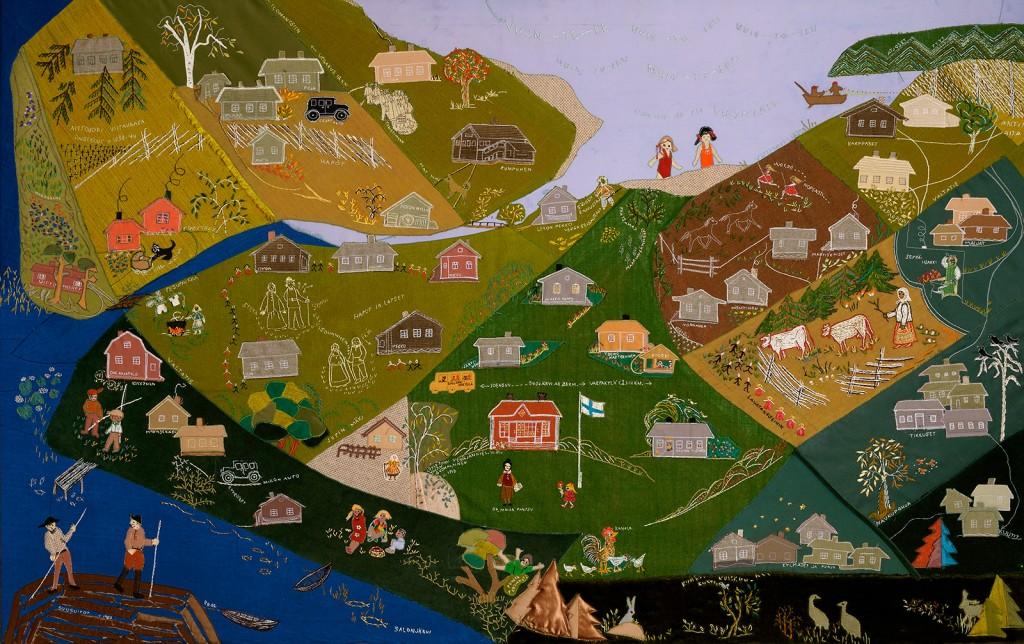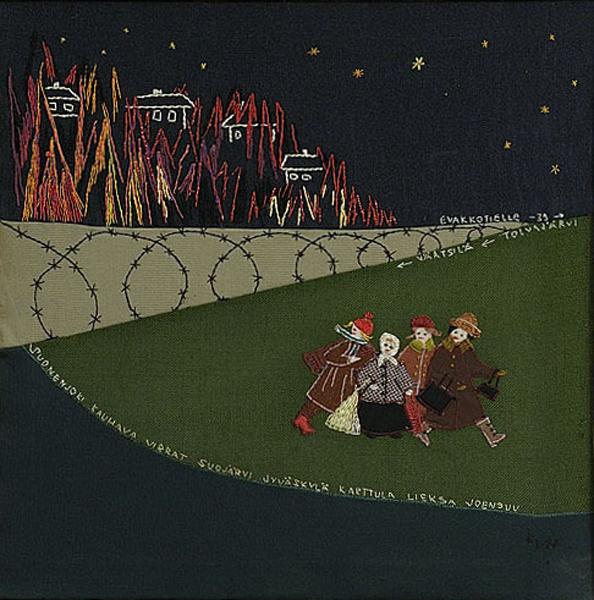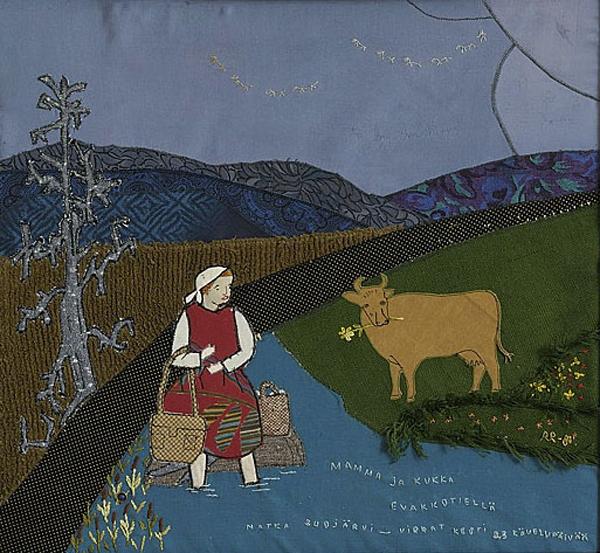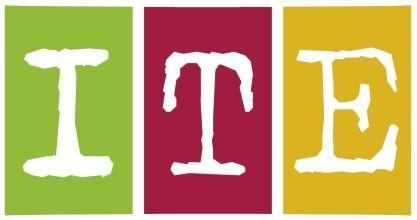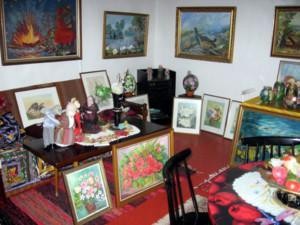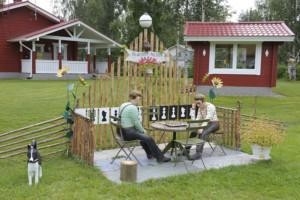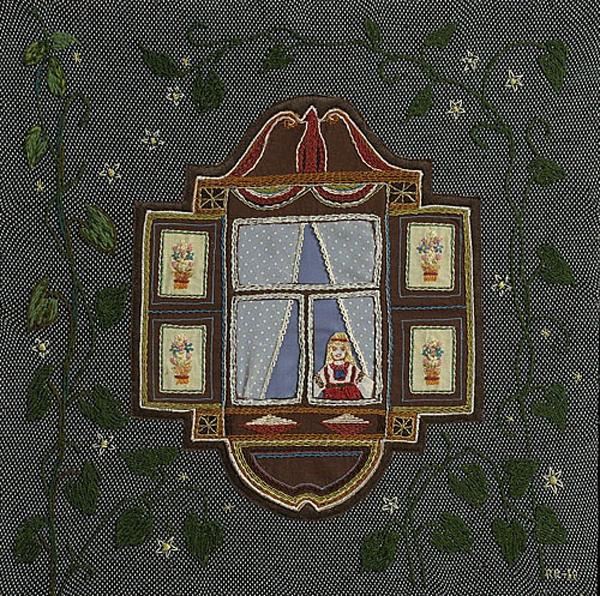
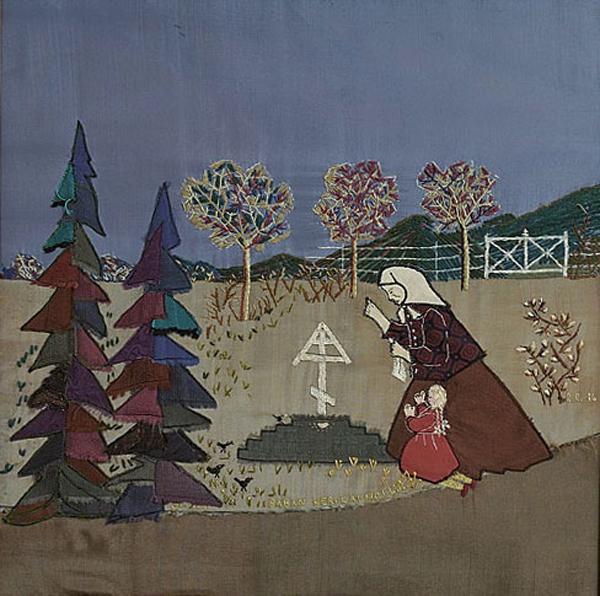
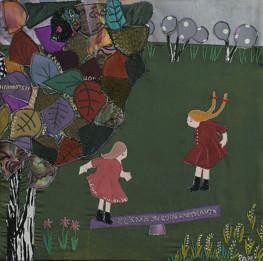
Rauha Ryynänen
Lieksa (1921–2011)
Rauha Ryynänen has used a mixture of techniques in her autobiographical textile works: appliqué, patchwork and embroidery. All her works share one feature: they are executed with an unfailing eye for colours. Shades of green, blue and lilac match perfectly and are seasoned with red details. Ryynänen’s works depict her childhood in the village of Vuontele in Karelia, the wartime, travelling as an evacuee as well as important people and events in her life.
When Ryynänen started sewing her autobiographical appliqué works at the turn of the 1980s, her idea was to tell her children and grandchildren about her own and her family’s history. The largest of her 21 works measures 133 cm x 204 cm and took a year and a half to complete. It depicts the village of Vuontele, which was situated in beautiful surroundings on the isthmus between lakes Salonjärvi and Vuonneljärvi. There were 52 houses in the village. Ryynänen meticulously put each house in its correct place and embroidered the name of the family and their children beside each house. The Vuontele of her memories is filled with charming details. A crowd of young people are going to a dance with Roope carrying his gramophone. Iisakki the smith hammers iron in the hot light of the furnace. Pekko Levo, a weather forecaster and a healer, walks in his garden, where he grows heath spotted orchid and buckthorn used in folk medicine. Ryynänen’s childhood home and school are located in the middle of the village. Her mother and aunt ran the village shop and post office so the home had a central role in many senses. She depicts herself four times in the picture: bringing flowers to her teacher, enjoying a picnic, running away from a bolting horse with her sister Lempi and swimming in lake Vuonneljärvi. Even the village’s two cars and the Suojärvi-Värtsilä-Joensuu coach can be found in the picture. Ryynänen’s choice of materials is innovative. Each detail is made of a suitable material; for instance, the beams of the houses are made of corduroy sewn horizontally.
Ryynänen has been interested in handicrafts since she was a child and she used a sewing machine for the first time when she was five years old. Her mother would even sell her needlework, and there was always plenty of patches and thread available. Even at elementary school Ryynänen used to teach other pupils to sew and later she studied to be a craft teacher.
The Ryynänen family had to be evacuated in 1939. They managed to visit their home during the truce, but then had to leave again and this time for good. Ryynänen has depicted their travels in Meidän perhe evakkotiellä (‘Our family on the evacuation journey’) and Mamma ja Kukka evakkotiellä (‘Mother and Kukka on the evacuation journey’). Ryynänen’s mother walked for 23 days from Suojärvi to Virrat with Kukka the cow because she wanted to make sure that the dear cow would not get lost on the journey. “Kukka was the one who helped my mother in her life”, said Rauha Ryynänen.
When she was sewing intensively – sometimes she would work on many pieces simultaneously and would already have her next idea in her head – Ryynänen shared her memories with her children. She did not just tell them about her own history but history in general as well, such as old customs or building traditions as seen in Menshakoffin talo (‘The Menshakoff house’) and Menshakoffin talon ikkuna (‘The window of the Menshakoff house). Ryynänen’s grandmother, Akuliina Sorsa, was a great performer of laments. In Baban ker kalmoil (‘At the graves with my grandmother’) Rauha is with her grandmother, who seems to be crying. Ryynänen told her children how the graveyard’s gate was respected; one had to stop in front of it and bless oneself. With the stories connected to her works she has passed on information to her children that is not included in the works but will be easily remembered with the help of the pictures. She embroidered things that are important to her in the tree of life in Elämä on kuin hyppylauta (‘Life is like a springboard’): religion, hobbies, friends, health, home and work.
Of all her figurative works, Sota-ajan uni (‘A wartime dream’) stands out. It is gentle blue abstract work and Ryynänen’s personal favourite. “A wartime dream. That’s the one I like best.” It is about a dream she had during the war, which must have brought a moment of relief during the hard times. She reminisces about the dream as if she could still catch its atmosphere: “Everything was right, everything was good.”
Text and photos: Minna Tuuva. Translation: Kirsti Nurmela-Knox.
